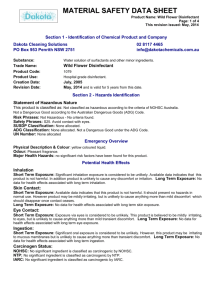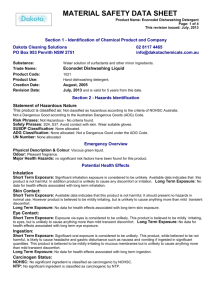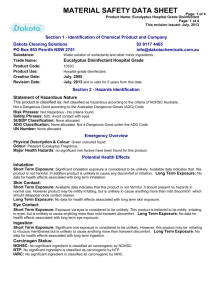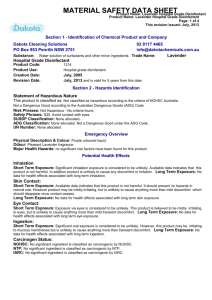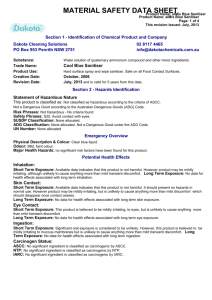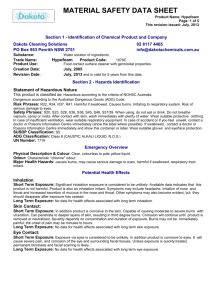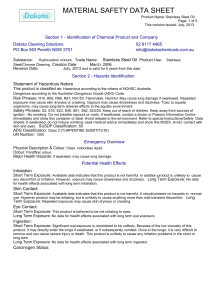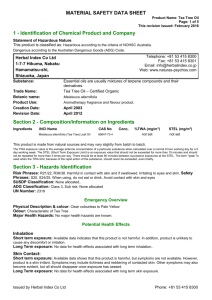MSDS Anti-Bacterial-Laundry-Powder
advertisement
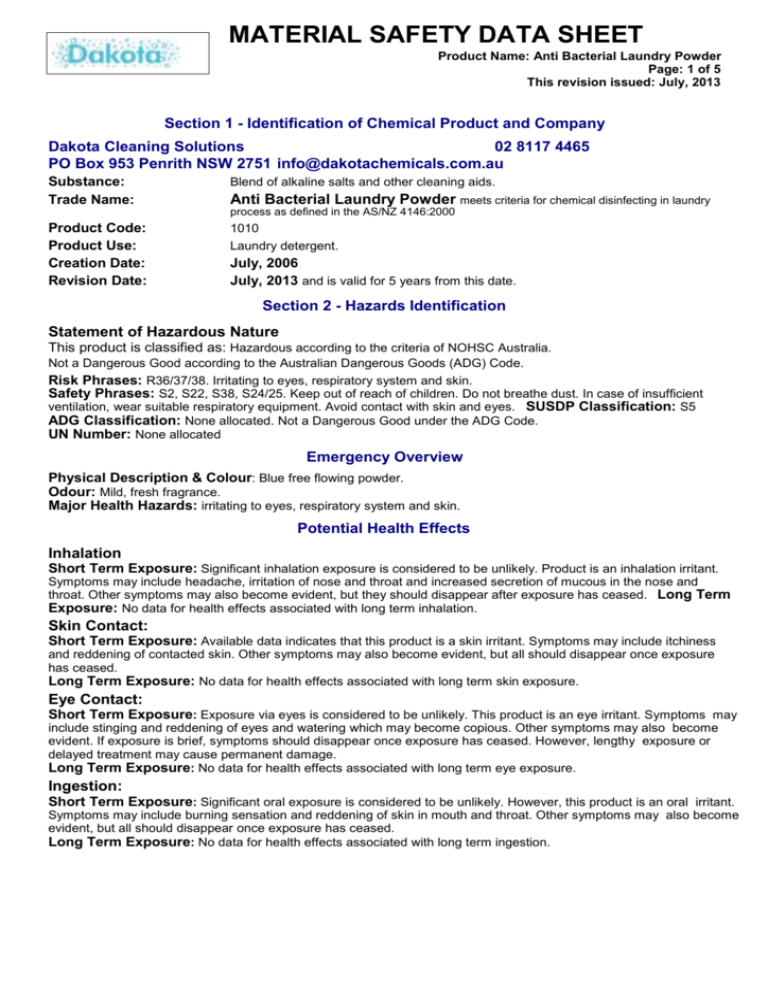
MATERIAL SAFETY DATA SHEET Product Name: Anti Bacterial Laundry Powder Page: 1 of 5 This revision issued: July, 2013 Section 1 - Identification of Chemical Product and Company Dakota Cleaning Solutions 02 8117 4465 PO Box 953 Penrith NSW 2751 info@dakotachemicals.com.au Substance: Trade Name: Blend of alkaline salts and other cleaning aids. Anti Bacterial Laundry Powder meets criteria for chemical disinfecting in laundry process as defined in the AS/NZ 4146:2000 Product Code: Product Use: Creation Date: Revision Date: 1010 Laundry detergent. July, 2006 July, 2013 and is valid for 5 years from this date. Section 2 - Hazards Identification Statement of Hazardous Nature This product is classified as: Hazardous according to the criteria of NOHSC Australia. Not a Dangerous Good according to the Australian Dangerous Goods (ADG) Code. Risk Phrases: R36/37/38. Irritating to eyes, respiratory system and skin. Safety Phrases: S2, S22, S38, S24/25. Keep out of reach of children. Do not breathe dust. In case of insufficient ventilation, wear suitable respiratory equipment. Avoid contact with skin and eyes. SUSDP Classification: S5 ADG Classification: None allocated. Not a Dangerous Good under the ADG Code. UN Number: None allocated Emergency Overview Physical Description & Colour: Blue free flowing powder. Odour: Mild, fresh fragrance. Major Health Hazards: irritating to eyes, respiratory system and skin. Potential Health Effects Inhalation Short Term Exposure: Significant inhalation exposure is considered to be unlikely. Product is an inhalation irritant. Symptoms may include headache, irritation of nose and throat and increased secretion of mucous in the nose and throat. Other symptoms may also become evident, but they should disappear after exposure has ceased. Long Term Exposure: No data for health effects associated with long term inhalation. Skin Contact: Short Term Exposure: Available data indicates that this product is a skin irritant. Symptoms may include itchiness and reddening of contacted skin. Other symptoms may also become evident, but all should disappear once exposure has ceased. Long Term Exposure: No data for health effects associated with long term skin exposure. Eye Contact: Short Term Exposure: Exposure via eyes is considered to be unlikely. This product is an eye irritant. Symptoms may include stinging and reddening of eyes and watering which may become copious. Other symptoms may also become evident. If exposure is brief, symptoms should disappear once exposure has ceased. However, lengthy exposure or delayed treatment may cause permanent damage. Long Term Exposure: No data for health effects associated with long term eye exposure. Ingestion: Short Term Exposure: Significant oral exposure is considered to be unlikely. However, this product is an oral irritant. Symptoms may include burning sensation and reddening of skin in mouth and throat. Other symptoms may also become evident, but all should disappear once exposure has ceased. Long Term Exposure: No data for health effects associated with long term ingestion. Product Name: Anti Bacterial Laundry Powder Page: 2 of 5 This revision issued: July, 2013 Carcinogen Status: NOHSC: No significant ingredient is classified as carcinogenic by NOHSC. NTP: No significant ingredient is classified as carcinogenic by NTP. IARC: No significant ingredient is classified as carcinogenic by IARC. Section 3 - Composition/Information on Ingredients Ingredients CAS No Conc,% TWA (mg/m3) STEL (mg/m3) Alkaline salts various 60-80 not set not set Quaternary ammonium compound 1 approx not set not set Other non hazardous ingredients secret to 100 not set not set This is a commercial product whose exact ratio of components may vary slightly. Minor quantities of other non hazardous ingredients are also possible. The TWA exposure value is the average airborne concentration of a particular substance when calculated over a normal 8 hour working day for a 5 day working week. The STEL (Short Term Exposure Limit) is an exposure value that should not be exceeded for more than 15 minutes and should not be repeated for more than 4 times per day. There should be at least 60 minutes between successive exposures at the STEL. The term "peak "is used when the TWA limit, because of the rapid action of the substance, should never be exceeded, even briefly. Section 4 - First Aid Measures General Information: You should call The Poisons Information Centre if you feel that you may have been poisoned, burned or irritated by this product. The number is 13 1126 from anywhere in Australia (0800 764 766 in New Zealand) and is available at all times. Have this MSDS with you when you call. Inhalation: If irritation occurs, contact a Poisons Information Centre, or call a doctor. Remove source of contamination or move victim to fresh air. If breathing is difficult, oxygen may be beneficial if administered by trained personnel, preferably on a doctor's advice. In severe cases, symptoms of pulmonary oedema can be delayed up to 48 hours after exposure. Skin Contact: Quickly and gently brush away excess solids. Wash gently and thoroughly with warm water (use nonabrasive soap if necessary) for 10-20 minutes or until product is removed. Under running water, remove contaminated clothing, shoes and leather goods (e.g. watchbands and belts) and completely decontaminate them before reuse or discard. If irritation persists, repeat flushing and seek medical attention. Eye Contact: Quickly and gently brush particles from eyes. Immediately flush the contaminated eye(s) with lukewarm, gently flowing water for 20 minutes or until the product is removed, while holding the eyelid(s) open. Take care not to rinse contaminated water into the unaffected eye or onto the face. Obtain medical attention immediately. Ingestion: If swallowed, do NOT induce vomiting. Wash mouth with water and contact a Poisons Information Centre, or call a doctor. Section 5 - Fire Fighting Measures Fire and Explosion Hazards: There is no risk of an explosion from this product under normal circumstances if it is involved in a fire. Only small quantities of decomposition products are expected from this products at temperatures normally achieved in a fire. Fire decomposition products from this product may be toxic if inhaled. Take appropriate protective measures. Extinguishing Media: Not Combustible. Use extinguishing media suited to burning materials. Fire Fighting: If a significant quantity of this product is involved in a fire, call the fire brigade. Flash point: Does not burn. Upper Flammability Limit: Does not burn. Lower Flammability Limit: Does not burn. Autoignition temperature: Not applicable - does not burn. Flammability Class: Does not burn. Section 6 - Accidental Release Measures Accidental release: In the event of a major spill, prevent spillage from entering drains or water courses. Evacuate the spill area and deny entry to unnecessary and unprotected personnel. Wear full protective clothing including eye/face protection. All skin areas should be covered. See below under Personal Protection regarding Australian Standards relating to personal protective equipment. Suitable materials for protective clothing include rubber, PVC. Eye/face protective equipment should comprise as a minimum, protective glasses and, preferably, goggles. If there is MATERIAL SAFETY DATA SHEET Issued by: Dakota Phone: 02 8117 4465 Product Name: Anti Bacterial Laundry Powder Page: 3 of 5 This revision issued: July, 2013 a significant chance that dusts are likely to build up in cleanup area, we recommend that you use a suitable Dust Mask. Use a P1 mask, designed for use against mechanically generated particles eg silica & asbestos. Stop leak if safe to do so, and contain spill. Sweep up and shovel or collect recoverable product into labelled containers for recycling or salvage, and dispose of promptly. Consider vacuuming if appropriate. Recycle containers wherever possible after careful cleaning. After spills, wash area preventing runoff from entering drains. If a significant quantity of material enters drains, advise emergency services. Contaminated area may be neutralised by washing with weak or dilute acid. Vinegar, citrus juice and most soft drinks may be suitable. This material may be suitable for approved landfill. Ensure legality of disposal by consulting regulations prior to disposal. Thoroughly launder protective clothing before storage or re-use. Advise laundry of nature of contamination when sending contaminated clothing to laundry. Section 7 - Handling and Storage Handling: Keep exposure to this product to a minimum, and minimise the quantities kept in work areas. Check Section 8 of this MSDS for details of personal protective measures, and make sure that those measures are followed. The measures detailed below under "Storage" should be followed during handling in order to minimise risks to persons using the product in the workplace. Also, avoid contact or contamination of product with incompatible materials listed in Section 10. Storage: This product is a Scheduled Poison. Observe all relevant regulations regarding sale, transport and storage of this schedule of poison. Keep containers dry and away from water. Make sure that the product does not come into contact with substances listed under "Incompatibilities" in Section 10. Check packaging - there may be further storage instructions on the label. Section 8 - Exposure Controls and Personal Protection The following Australian Standards will provide general advice regarding safety clothing and equipment: Respiratory equipment: AS/NZS 1715, Protective Gloves: AS 2161, Industrial Clothing: AS2919, Industrial Eye Protection: AS1336 and AS/NZS 1337, Occupational Protective Footwear: AS/NZS2210. Exposure Limits TWA (mg/m3) STEL (mg/m3) Exposure limits have not been established by NOHSC for any of the significant ingredients in this product. No special equipment is usually needed when occasionally handling small quantities. The following instructions are for bulk handling or where regular exposure in an occupational setting occurs without proper containment systems. Ventilation: No special ventilation requirements are normally necessary for this product. However make sure that the work environment remains clean and that dusts are minimised. Eye Protection: Protective glasses or goggles should be worn when this product is being used. Failure to protect your eyes may cause them harm. Emergency eye wash facilities are also recommended in an area close to where this product is being used. Skin Protection: Prevent skin contact by wearing impervious gloves, clothes and, preferably, apron. Make sure that all skin areas are covered. See below for suitable material types. Protective Material Types: We suggest that protective clothing be made from the following materials: rubber, PVC. Respirator: If there is a significant chance that dusts are likely to build up in the area where this product is being used, we recommend that you use a suitable Dust Mask. Eyebaths or eyewash stations and safety deluge showers should be provided near to where this product is being used. Section 9 - Physical and Chemical Properties: Physical Description & colour: Blue free flowing powder. Odour: Mild, fresh fragrance. Boiling Point: Not available. Freezing/Melting Point: No specific data. Solid at normal temperatures. Volatiles: No specific data. Expected to be low at 100°C. Vapour Pressure: Negligible at normal ambient temperatures. Vapour Density: No data. Specific Gravity: No data. Water Solubility: Completely soluble in water. pH: pH of 1% solution in water is 11.4-12.0 approx Volatility: Negligible at normal ambient temperatures. Odour Threshold: No data. Evaporation Rate: No data. Coeff Oil/water Distribution: No data MATERIAL SAFETY DATA SHEET Issued by: Dakota Phone: 02 8117 4465 Autoignition temp: Product Name: Anti Bacterial Laundry Powder Page: 4 of 5 This revision issued: July, 2013 Not applicable - does not burn. Section 10 - Stability and Reactivity Reactivity: This product is unlikely to react or decompose under normal storage conditions. However, if you have any doubts, contact the supplier for advice on shelf life properties. Conditions to Avoid: Containers should be kept dry. Incompatibilities: water, acids, zinc, tin, aluminium and their alloys. Fire Decomposition: Only small quantities of decomposition products are expected from this products at temperatures normally achieved in a fire. Carbon dioxide, and if combustion is incomplete, carbon monoxide and smoke. Nitrogen and its compounds, and under some circumstances, oxides of nitrogen. Occasionally hydrogen cyanide gas. Oxides of sulfur (sulfur dioxide is a respiratory hazard) and other sulfur compounds. Most will have a foul odour. Water. Carbon monoxide poisoning produces headache, weakness, nausea, dizziness, confusion, dimness of vision, disturbance of judgment, and unconsciousness followed by coma and death. Polymerisation: This product will not undergo polymerisation reactions. Section 11 - Toxicological Information Local Effects: Target Organs: none known Classification of Hazardous Ingredients Ingredient Risk Phrases No ingredient mentioned in the List of Designated Hazardous Substances is present in this product at hazardous concentrations. Section 12 - Ecological Information This product does not degrade naturally. It will not cause ecological problems because it does not enter biological systems. Section 13 - Disposal Considerations Disposal: Containers should be emptied as completely as practical before disposal. If possible, recycle containers either in-house or send to recycle company. If this is not practical, send to a commercial waste disposal site. This product should be suitable for landfill. However, check with local Waste Disposal Authority before sending there. Note that product properties may have been changed in use, significantly altering it's suitability for landfill. Please do NOT dispose into sewers or waterways. Section 14 - Transport Information ADG Code: This product is not classified as a Dangerous Good. No special transport conditions are necessary unless required by other regulations. Section 15 - Regulatory Information AICS: All of the significant ingredients in this formulation are to be found in the public AICS Database. The following ingredient: alkaline salts is mentioned in the SUSDP. Section 16 - Other Information This MSDS contains only safety-related information. For other data see product literature. Acronyms: ADG Code AICS CAS Number Hazchem Code IARC NOHSC NOS NTP R-Phrase SUSDP Australian Code for the Transport of Dangerous Goods by Road and Rail Australian Inventory of Chemical Substances Chemical Abstracts Service Registry Number Emergency action code of numbers and letters that provide information to emergency services especially firefighters International Agency for Research on Cancer National Occupational Health and Safety Commission Not otherwise specified National Toxicology Program (USA) Risk Phrase Standard for the Uniform Scheduling of Drugs & Poisons MATERIAL SAFETY DATA SHEET Issued by: Dakota Phone: 02 8117 4465 UN Number Product Name: Anti Bacterial Laundry Powder Page: 5 of 5 This revision issued: July, 2013 United Nations Number THIS MSDS SUMMARISES OUR BEST KNOWLEDGE OF THE HEALTH AND SAFETY HAZARD INFORMATION OF THE PRODUCT AND HOW TO SAFELY HANDLE AND USE THE PRODUCT IN THE WORKPLACE. EACH USER MUST REVIEW THIS MSDS IN THE CONTEXT OF HOW THE PRODUCT WILL BE HANDLED AND USED IN THE WORKPLACE. IF CLARIFICATION OR FURTHER INFORMATION IS NEEDED TO ENSURE THAT AN APPROPRIATE RISK ASSESSMENT CAN BE MADE, THE USER SHOULD CONTACT THIS COMPANY SO WE CAN ATTEMPT TO OBTAIN ADDITIONAL INFORMATION FROM OUR SUPPLIERS OUR RESPONSIBILITY FOR PRODUCTS SOLD IS SUBJECT TO OUR STANDARD TERMS AND CONDITIONS, A COPY OF WHICH IS SENT TO OUR CUSTOMERS AND IS ALSO AVAILABLE ON REQUEST. Please read all labels carefully before using product. This MSDS is prepared in accord with the NOHSC document “National Code of Practice for the Preparation of Material Safety Data Sheets” 2nd Edition [NOHSC:2011(2003)] Copyright © Kilford & Kilford Pty Ltd, June, 2011. http://www.kilford.com.au/ Phone (02)9251 4532 MATERIAL SAFETY DATA SHEET Issued by: Dakota Phone: 02 8117 4465
